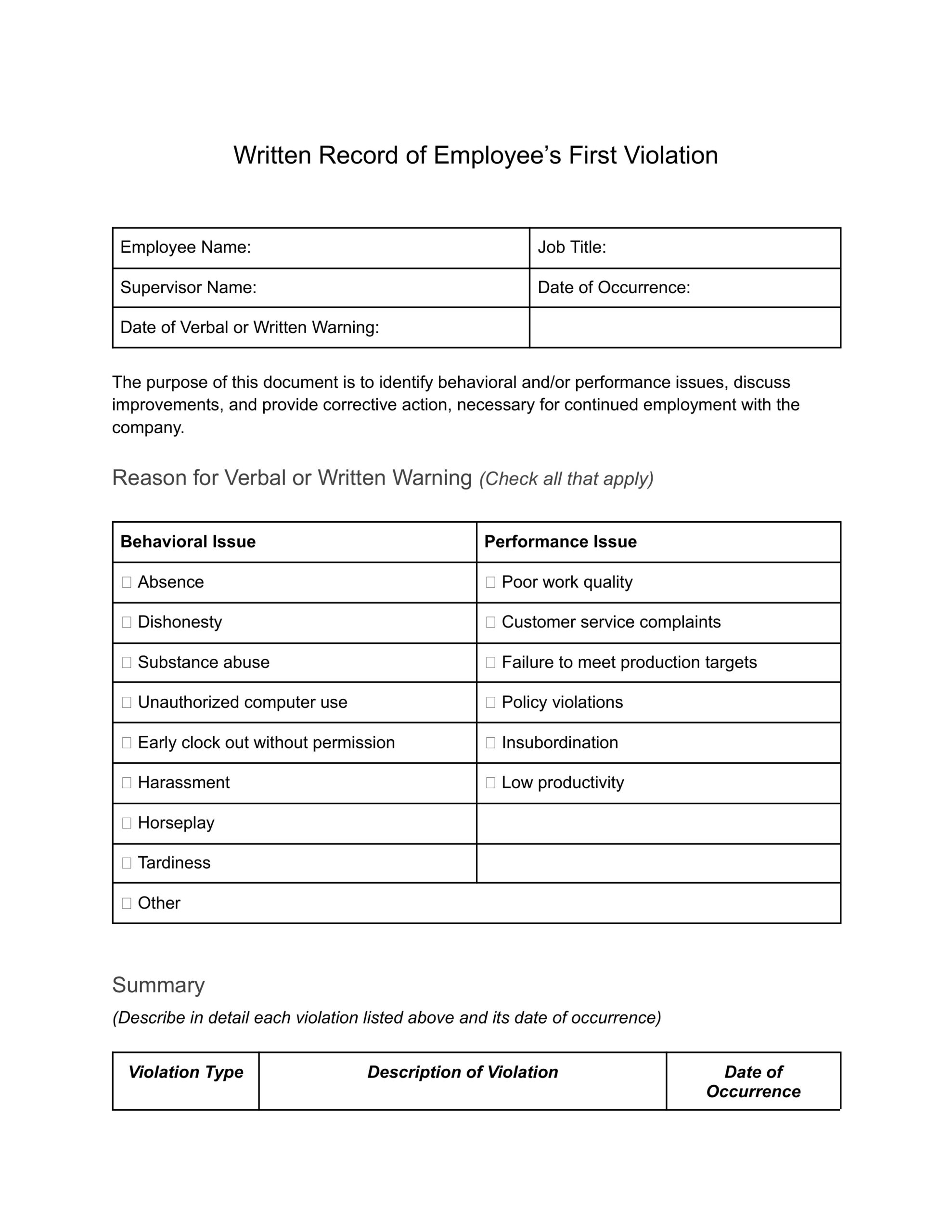
An employee write up form is a document that records an employee’s violation of a company policy, behavior issues, or failure to meet stated goals once these reach a point that requires disciplinary action. A write up template should be used company-wide and completed by the employee’s supervisor, HR, or both. Follow your company’s employee discipline policy and process every time you need to write an employee up.
Learn the step-by-step process for creating and managing write-up forms for your employees. Plus, download our free first violation, performance issues, and behavior issues templates to get started.
FILE TO DOWNLOAD OR INTEGRATE
Written Record of Employee’s First Violation
Download as Word Doc Download as Google Doc Download as PDF
Thank you for downloading. If you are looking for HR software that can help you create disciplinary templates as well as policies, consider BambooHR. Start now with a free trial! Visit BambooHR
Select Download Type FILE TO DOWNLOAD OR INTEGRATE Written Employee Warning for Performance Issues Download as Word Doc Download as Google Doc Download as PDF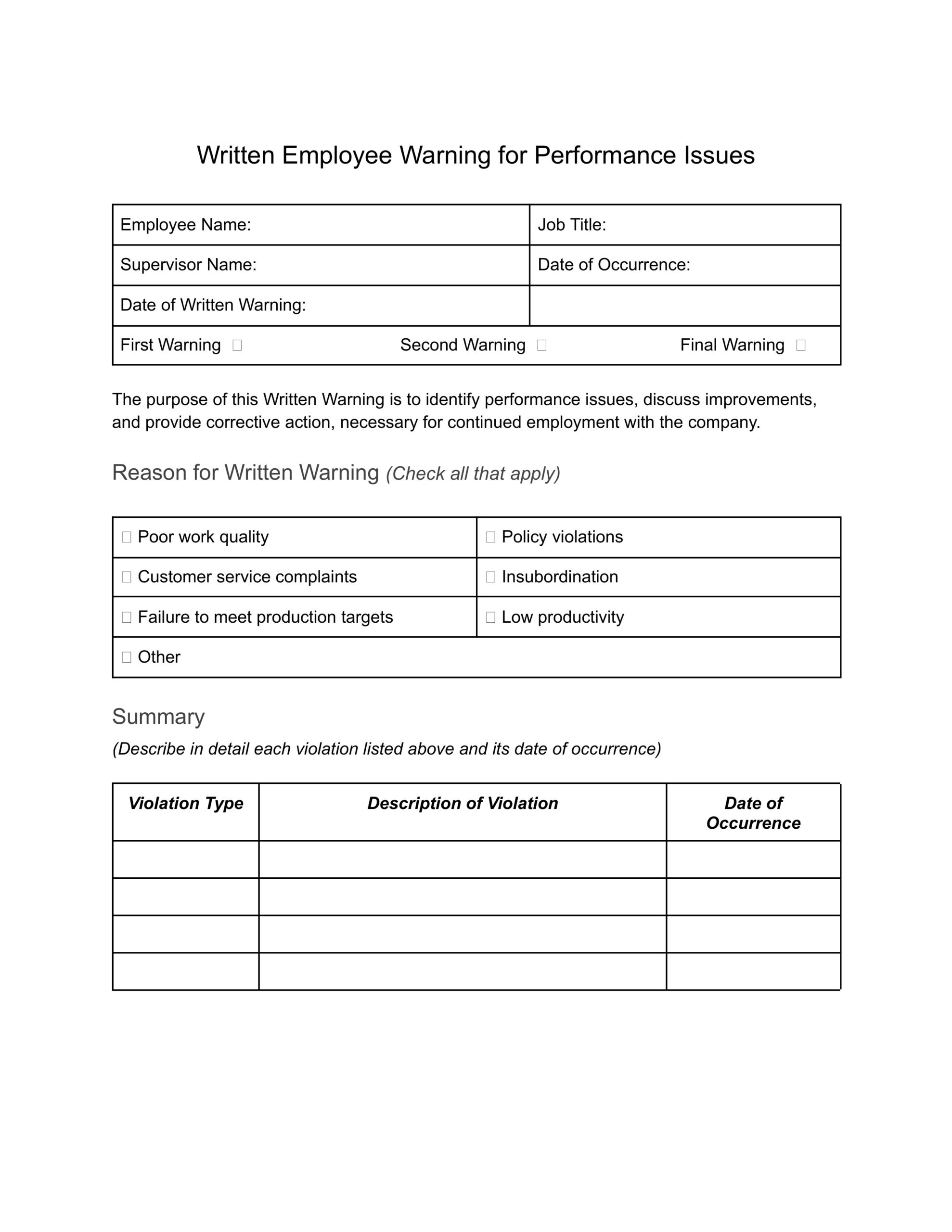
Thank you for downloading. If you are looking for HR software that can help you create disciplinary templates as well as policies, consider BambooHR. Start now with a free trial! Visit BambooHR
Select Download Type FILE TO DOWNLOAD OR INTEGRATE Written Employee Warning for Behavior Issues Download as Word Doc Download as Google Doc Download as PDF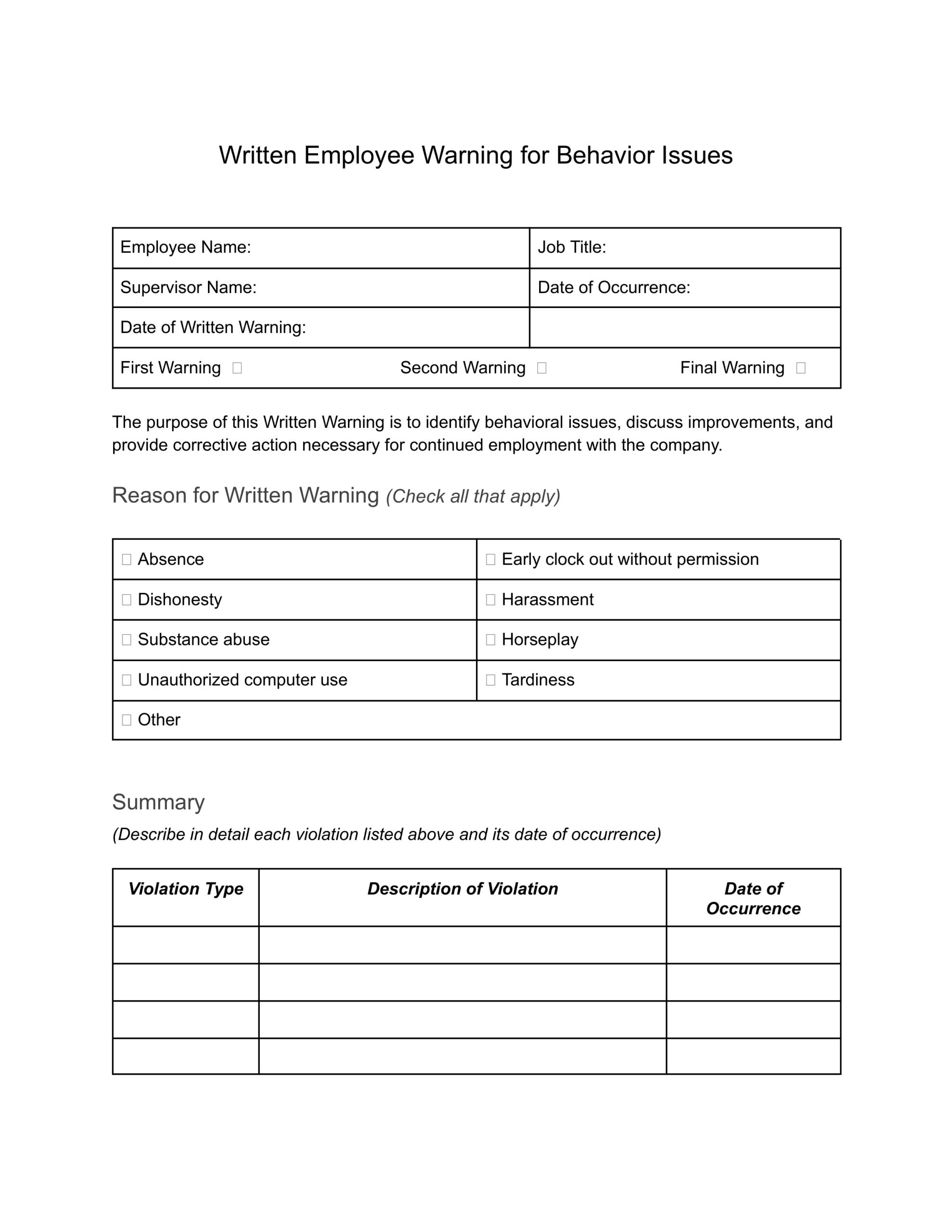
Thank you for downloading. If you are looking for HR software that can help you create disciplinary templates as well as policies, consider BambooHR. Start now with a free trial! Visit BambooHR
Select Download TypeSeveral key sections help make an employee write-up form more solid, especially in the event of a lawsuit. You’ll need to outline the reason for the write-up in as much detail as possible, along with any dates and related conversations you’ve had regarding the issue.
Type of WarningAn employee should first receive a verbal warning as part of a progressive discipline policy. This warning should be documented as a precursor to a formal written warning if the employee does not improve their performance or behavior.

Input the employee’s information, including the date of occurrence and whether it is a first, second, or final warning.
If the employee has already received a verbal warning or a prior written warning, you need to mark the form accordingly—first warning, second warning, or final warning. The purpose of doing so is to communicate to the employee the increased severity of their actions and ensure your company remains compliant by following a fair and equitable process for all employees.
Reason for Warning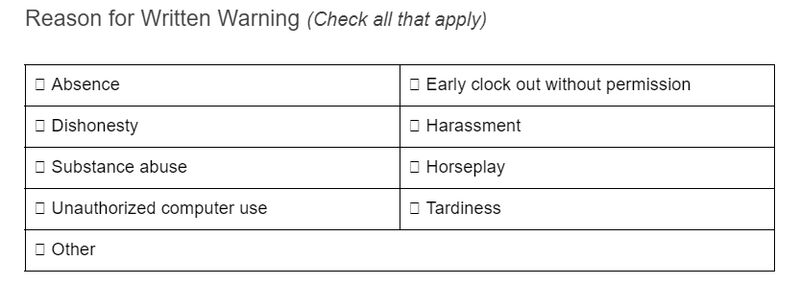
Check the box that corresponds with the reason for the written warning or check “Other” and provide an explanation.
Once you check the reason for the written warning, provide an explanation of each violation that requires corrective action. Be sure to be as detailed as possible so the employee fully understands the reason for the warning.
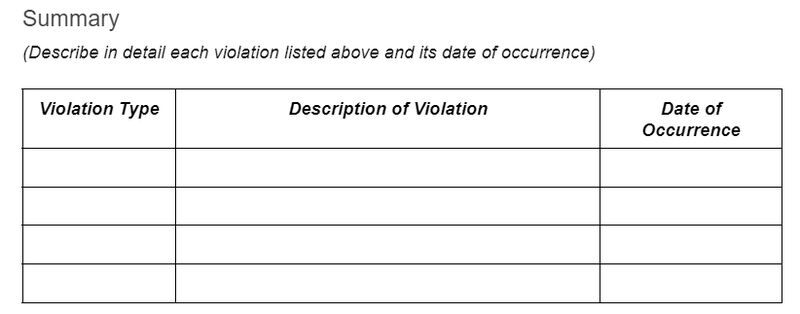
List the violation type, provide a detailed explanation, and the date of occurrence for each violation.
Providing vague reasons or one-word responses will lead to employees being confused. When employees are unsure of why they’re being reprimanded, they can become disengaged and frustrated, having the opposite effect of what you intend. Most employees want to know if they’re not meeting your standards, and they also want to know, specifically, what went wrong and how they can improve. Giving vague reasons makes employees feel you’re setting them up to fail.
Prior DiscussionsWhenever you write an employee up, you need to include notes about prior verbal warnings or write-ups that relate to the present action. Including the history makes it easy for everyone involved to understand why this next step is being taken.
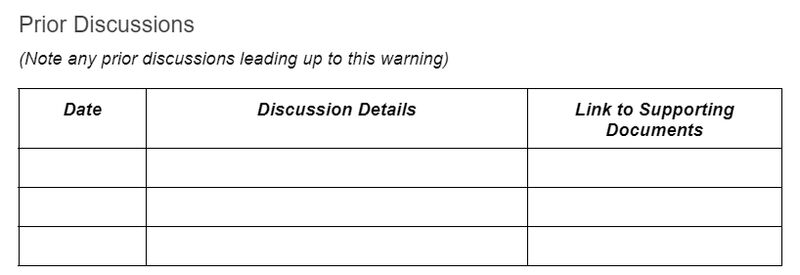
Provide the date, brief discussion details, and a link to support documents.
Ensure that you have documentation of your prior discussions on this topic with this employee. You can keep this section short by referring back to those documents for additional information.
Corrective ActionDescribing what they need to do to improve their performance or behavior is the most crucial part of the employee write-up form. As the employee’s manager, one part of your role is to ensure your team has the tools to succeed. If you have an employee who is missing deadlines or turning in poor work, it’s your responsibility to redirect them and provide the support they need.
When defining the corrective action necessary, be specific. Include milestones or checkpoints and a timeline to review their performance. Describe how you will be actionably involved and available to help them become successful.
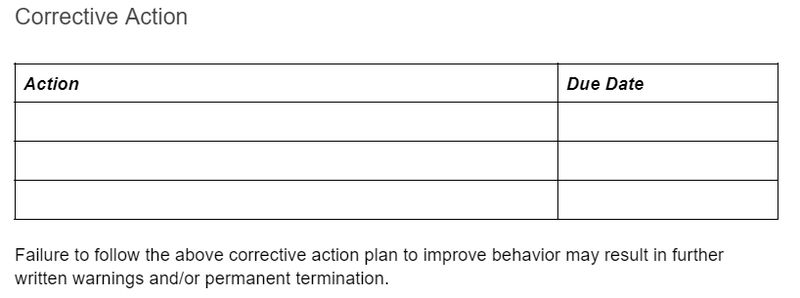
List the action required and due date, and follow up with next steps should the employee fail to complete the actions required.
Discuss what’s next if the employee does not correct their performance or behavior. That could include another write-up or even termination. Be sure to keep this consistent with your company’s progressive discipline policy.
For help communicating which corrective actions the employee should take, check out our guide to creating a performance improvement plan.
Employee StatementWhile most employees will sign, some may protest. They may disagree with what is written or simply do not want to acknowledge you provided them with a copy of the write-up. If you encounter this scenario, you can provide space for the employee to write a rebuttal, which can give employees peace of mind that their points are being heard.

Provide space for the employee to list their thoughts.
Employee AcknowledgementOne of the best ways to ensure that employees sign the write-up is to put acknowledgment language on their signature block stating that the employee only acknowledges they have received the document, not that they agree with everything written. Then have them sign. Signatures are proof that you and the employee spoke about the write-up. Getting the employee to sign a document proves they received and reviewed it.
Some employees refuse to sign a write-up. If this happens, don’t get combative. Instead, document that you gave the employee a copy of the write-up but they refused to sign. Then, have a member of HR sign the document, attesting that the employee received a copy but refused to sign.

Have the employee acknowledge they have received and read the write up document.
Supervisor/HR AcknowledgementThe final step on the employee write up warning form is to have a supervisor and/or HR representative sign as a witness.

The employee’s supervisor and a member of HR should both sign the document as witnesses.
For help creating your employee write-up forms and disciplinary policies, consider using BambooHR. It is a customizable HR software that will allow you to not only create templates but also track applicants, manage employee information, measure staff engagement, conduct performance reviews, and more. To learn more, read our BambooHR review.
To successfully complete an employee write-up, follow the steps below.
Never simply hand the employee a write-up form and send them on their way. To show your team that you’re involved in their success, interact with them and discuss how you’re going to help them improve. Whether you’re giving a verbal warning or a write-up, you must discuss it with the employee.
Discussing the problem areas with the employee makes them feel like a valuable member of the team and not simply someone you are looking to terminate. Solid people management skills include the ability to have tough conversations.
For example, if you’re writing an employee up for excessive tardiness, having a discussion with them could uncover the reasons they’ve been late. Don’t just assume ill intent. Understanding the reasons something happens can help you proactively correct the behavior.
There are some offenses an employee can commit that may make you want to bypass the write-up stage and lead directly to termination. Check out our list of the top fireable offenses to learn more.
As part of the corrective action section of your employee write-up form, you will need to include details about check-in meetings and how the employee successfully resolved the issue. Document every check-in you have with the employee, discussing their progress and any support you have provided. Remember, your goal is to help the employee succeed, and that will include involvement and effort on your part.
Sometimes an employee write-up does not end successfully. When that happens, you may decide to end the employment relationship with the underperforming employee.
If the write-up form noted that termination would result if the employee fails to correct their performance or behavior, you need to follow through. While an unpleasant process, you need to ensure that employees are held accountable. Make sure you know how to terminate an employee effectively and legally.
Always provide a copy of a write-up form to the employee and keep the original in their personnel file. Limit access to employee personnel files to HR only to help ensure that employees’ information is kept confidential and your company respects their privacy.
When there’s an employment dispute or a former employee sues for wrongful termination, the first document request from their legal counsel will be for the employee’s personnel file, which contains their write-up forms. If you don’t have those forms in the employee’s file, you don’t have evidence supporting your decision to terminate an employee. This could be a costly oversight.
Aside from making sure you keep records of all written warnings, be sure to follow up with the employee regarding their corrective action plan and areas for continued improvement.
A detailed write up form example should include the reason for the formal write up for the employee, any prior discussions, and corrective actions. Additionally, have the employee sign the document as an acknowledgment of the write up. It should also be signed by the employee’s manager and/or a member of HR.
What is a write up in HR?An employee disciplinary action form template is usually focused on performance or behavioral issues. These write ups typically come from a manager or supervisor but can also be handled by human resources (HR). HR will also sign the form and keep a copy in the employee’s personnel file.
What is the format for a write up?The format you choose to use for an employee write up is up to you, however, we recommend including the reason why the employee is being written up and a course of action for correcting the behavior.
Completing an employee write-up form is a necessary part of managing employees and an effective tool for disciplining employees. Through proper documentation, you can help your employees be better workers and give your company firm footing if an employee ever alleges discrimination or wrongful termination.
Find Jennifer On LinkedIn
Jennifer Soper has 25+ years of writing and content design experience, working with small businesses and Fortune 100 companies. For over a decade, Jennifer worked as an HR generalist, providing expertise in accounting, payroll, and HR by implementing payroll and benefits best practices and creating onboarding and employee-relations documentation.